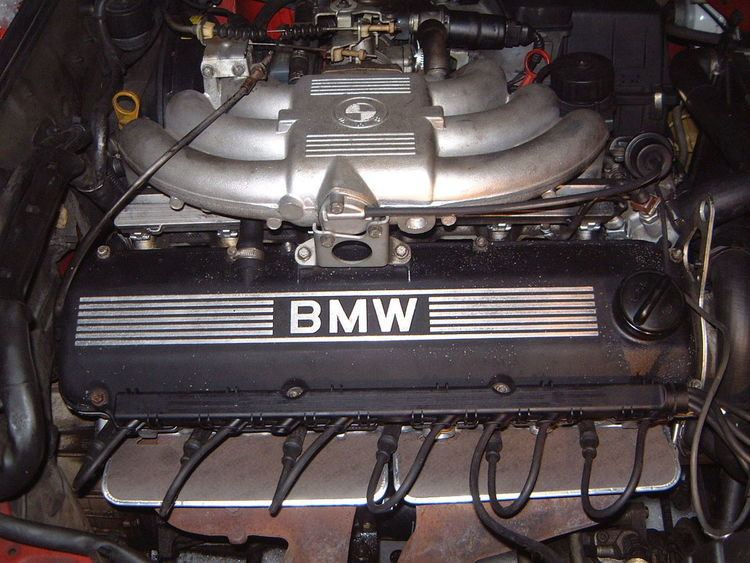Manufacturer BMW Configuration Straight-six engine | Production 1977–1993 | |
 | ||
Displacement 2.0 L (1991 cc; 121.5 cu in)2.3 L (2316 cc; 141.3 cu in)2.5 L (2494 cc; 152.2 cu in)2.7 L (2693 cc; 164.3 cu in) Cylinder bore 80 mm (3.1 in) (2.0, 2.3)84 mm (3.3 in) (2.5, 2.7) Piston stroke 66 mm (2.6 in) (2.0)75 mm (3.0 in) (2.5)76.8 mm (3.0 in) (2.3)81 mm (3.2 in) (2.7) | ||
The BMW M20 is a straight-six SOHC piston engine produced from 1977-1993. It was released in 1977 in the E12 520/6 and E21 320/6 and began to be phased out following the introduction of the M50 engine in 1990.
Contents
Like the larger capacity M30 engine from which it is derived, the M20 has a SOHC and 2 valves per cylinder. While the M30 camshaft is chain driven, the M20 camshaft and auxiliary shaft are driven by a timing belt. Initially released with a carburetor, later models used Bosch fuel injection.
History
With displacements ranging from 1991 cc to 2693 cc, it was the "little brother" to the larger BMW M30. It has 91 mm (3.6 in) bore-spacing instead of the 100 mm (3.9 in) of the M30 six-cylinder and the M10 four-cylinder engines.
Powering the E21 and E30 3-Series, as well as E12, E28 and E34 5 Series cars, it was produced for nearly two decades, with the last examples powering the E30 325i touring built until April 1993.
Early versions of the M20 were sometimes referred to as the "M60", although the M60 code has since been used by BMW for a V8 engine produced from 1992-1996.
The M20 was the basis for the M21 diesel engine and the M70 V12 engine.
M20B20
The first models to use the M20 were the E12 520/6 and the E21 320/6, which used the 1991 cc M20B20. This engine uses a bore of 80 mm (3.1 in) and a stroke of 66 mm (2.6 in). Fuel was supplied by a Solex 4A1 four-barrel carburetor.
The M20B20 first became fuel-injected in the 1982 520i, with Bosch K-Jetronic used. In 1984, the fuel injection was updated to L-Jetronic. In 1987, the M20B20 was again revised with the addition of Bosch Motronic engine management and a catalytic converter.
Applications:
M20B23
The 2.3 litre M20B23 used the same head (known as "731") and block as the carbureted 2.0 litre but used a longer 76.8 mm (3.0 in) stroke crank. The engine was first used in E21 323i and was replaced by the M20B25 in 1985.
The E30 version used L-Jetronic. and initially produced 102 kW (137 hp), which was increased to 110 kW (150 hp) in 1984. The 102 kW version continued to be available in certain markets with strict emissions regulations, such as Switzerland, until replaced by the 325i.
The M20B23 was not sold in North America.
Applications:
M20B25
The M20B25 has a capacity of 2494 cc and produced 126 kW (169 hp) (without a catalytic converter). The M20B25 head is known as "885" (since the casting number ends in 885), it has a bore of 84 mm (3.3 in), a stroke of 75 mm (3.0 in), a compression ratio of 9,7:1 and used the Bosch Motronic 1.1/1.3 engine management system. North American models used a lower compression ratio of 8.8:1.
Applications:
M20B27
The 2693 cc M20B27 was designed for efficiency (thus the e for the Greek letter eta in 325e) and low-rev torque. Compared with the M20B25, the stroke is increased from 75 mm (3.0 in) to 81 mm (3.2 in). The B27 used the head casting of '200' which had smaller valves, different camshafts, fewer cam journals, and single valve springs to increase efficiency. Due to these changes the rev limit on the B27 was reduced.
Power output is 121 hp (90 kW) at 4,250 rpm for M20B27 engines produced up until 1987 and 127 hp (95 kW) at 4,800 rpm for the "325es" model produced in 1988. Peak torque is 170 lb·ft (230 N·m) at 3,250 rpm for M20B27 engines. In 1987, the fuel injection was upgraded from Motronic 1.0 to Motronic 1.1/1.3. In the early 1990's BMW South Africa used components from the Alpina C3 2.7 to produce a E30 specifically for Stannic Group N production car racing. The first iteration of this engine used in the E30 325iS produced 145kw and the second revision, often referred to as "Evo2" or on the VIN plate as "HP2" produced 155kw.
Applications:
